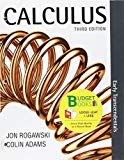
(a)
The mathematical proof of the statement stating that using L'Hopital Rule, , though not defined at x = 0, can be made continuous by assigning the value
Answer to Problem 53E
Solution: The mathematical proof of the statement stating that using L'Hopital Rule, , though not defined at x = 0, can be made continuous by assigning the value is derived.
Explanation of Solution
Explanation:
Given: for a>0
Calculation:
Step 1: The function , is continuous if .
Step 2: We verify this limit using L'Hopital Rule:
Therefore, f is continuous.
Conclusion: The statement stating that using L'Hopital Rule, , though not defined at x = 0, can be made continuous by assigning the value is mathematically proved.
(b)
The mathematical proof of the statement stating that for using triangle inequality and the mathematical proof of the statement stating that I(a) converges by applying the Comparison Theorem
Answer to Problem 53E
Solution: Both the mathematical proof of the statement stating that for using triangle inequality and the mathematical proof of the statement stating that I(a) converges by applying the Comparison Theorem are derived.
Explanation of Solution
Given: , , , a > 0
Calculation:
Step 1: We now show that the following integral converges:
(a>0)
Since, then for x > 0
If x > 1 we have,
That is for x > 1
Step 2: Also, since we have for x > 1
Thus, we get
Step 3: Hence, from Step 1 and Step 2, we get
Step 4: We now show that the integral of the right hand side converges:
Since the integral converges, we conclude from Step 3 and the Comparison Test for Improper Integral that
also converges for a > 0.
Conclusion: Both the statement stating that for using triangle inequality and the statement stating that I(a) converges by applying the Comparison Theorem are mathematically proved.
(c)
The mathematical proof of the equation
Answer to Problem 53E
Solution: The mathematical proof of the equation is derived
Explanation of Solution
Given: , a>0
Calculation:
Step 1: We compute the inner integral with respect to y:
Step 2: Hence,
Conclusion: The equation is mathematically proved.
(d)
By interchanging the order of
Answer to Problem 53E
Solution: By interchanging the order of integration, the mathematical proof of the equation
is derived.
Explanation of Solution
Given: , a>0
Calculation:
Step 1: By the definition of the improper integral,
Step 2: We compute the double integral. Using Fubini's Theorem we may compute the iterated integral using the reversed order of integration. That is,
Combining with Step 1, we get,
Conclusion: By interchanging the order of integration, the equation is mathematically proved.
(e)
The mathematical proof of the statement stating the limit in is zero by using the Comparison Theorem.
Answer to Problem 53E
Solution: The mathematical proof of the statement stating the limit in is zero by using the Comparison Theorem is derived.
Explanation of Solution
Given: , a>0
Calculation:
Step 1: We consider the following possible cases:
Case 1: then in the interval of integration . As , we may assume that T > 0
Thus,
Hence,
By the limit and the Squeeze Theorem, we conclude that,
Case 2:
Then,
and in the interval of integration , therefore
(the function is decreasing).
Hence,
By the limit and the Squeeze Theorem, we conclude that
We thus showed that for all a > 0,
Conclusion: The statement stating the limit in is zero by using the Comparison Theorem is mathematically proved.
Want to see more full solutions like this?
Chapter 15 Solutions
Loose-leaf Version for Calculus: Early Transcendentals Combo 3e & WebAssign for Calculus: Early Transcendentals 3e (Life of Edition)
- Use Green's Theorem to evaluate F. dr, where F = (√+4y, 2x + √√) and C consists of the arc of the curve y = 4x - x² from (0,0) to (4,0) and the line segment from (4,0) to (0,0).arrow_forwardEvaluate F. dr where F(x, y, z) = (2yz cos(xyz), 2xzcos(xyz), 2xy cos(xyz)) and C is the line π 1 1 segment starting at the point (8, ' and ending at the point (3, 2 3'6arrow_forwardCan you help me find the result of an integral + a 炉[メをメ +炉なarrow_forward
- I need help making sure that I explain this part accutartly.arrow_forwardPlease help me with this question as I want to know how can I perform the partial fraction decompostion on this alebgric equation to find the time-domain of y(t)arrow_forwardPlease help me with this question as I want to know how can I perform the partial fraction on this alebgric equation to find the time-domain of y(t)arrow_forward
- Evaluate F³ - dr where ♬ = (4z, -4y, x), and C' is given by (t) = (sin(t), t, cos(t)), 0≤t≤ñ .arrow_forwardMid-Term Review Find the formula for (f + g)(x). f(x) = x² - 10x + 25 and g(x) = x² - 10x + 24 (f + g) (x) = [ 2 ]x² X + DELL Skip Sarrow_forwardCalculus III May I please have some elaborations on Example 2 part a? Thank you.arrow_forward
 Calculus: Early TranscendentalsCalculusISBN:9781285741550Author:James StewartPublisher:Cengage Learning
Calculus: Early TranscendentalsCalculusISBN:9781285741550Author:James StewartPublisher:Cengage Learning Thomas' Calculus (14th Edition)CalculusISBN:9780134438986Author:Joel R. Hass, Christopher E. Heil, Maurice D. WeirPublisher:PEARSON
Thomas' Calculus (14th Edition)CalculusISBN:9780134438986Author:Joel R. Hass, Christopher E. Heil, Maurice D. WeirPublisher:PEARSON Calculus: Early Transcendentals (3rd Edition)CalculusISBN:9780134763644Author:William L. Briggs, Lyle Cochran, Bernard Gillett, Eric SchulzPublisher:PEARSON
Calculus: Early Transcendentals (3rd Edition)CalculusISBN:9780134763644Author:William L. Briggs, Lyle Cochran, Bernard Gillett, Eric SchulzPublisher:PEARSON Calculus: Early TranscendentalsCalculusISBN:9781319050740Author:Jon Rogawski, Colin Adams, Robert FranzosaPublisher:W. H. Freeman
Calculus: Early TranscendentalsCalculusISBN:9781319050740Author:Jon Rogawski, Colin Adams, Robert FranzosaPublisher:W. H. Freeman
 Calculus: Early Transcendental FunctionsCalculusISBN:9781337552516Author:Ron Larson, Bruce H. EdwardsPublisher:Cengage Learning
Calculus: Early Transcendental FunctionsCalculusISBN:9781337552516Author:Ron Larson, Bruce H. EdwardsPublisher:Cengage Learning





